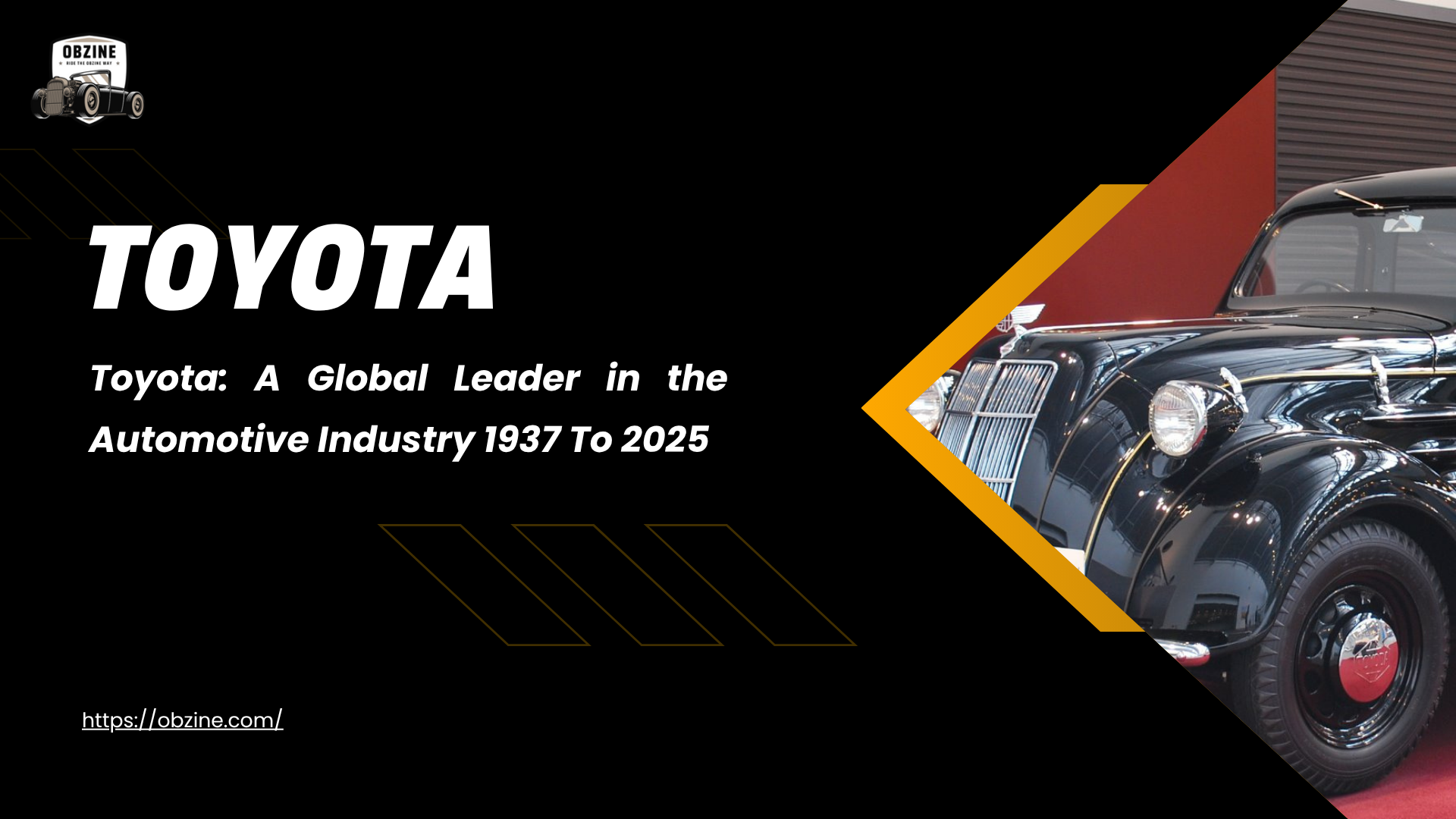Introduction
When discussing the world’s most respected and successful automobile companies, Toyota Motors Corporation stands as a towering figure. Based in Japan, Toyota is a name synonymous with reliability, innovation, and environmental responsibility. Over the decades, it has transformed from a domestic carmaker to a global icon, reshaping the way the world drives. This article takes a deep dive into Toyota’s history, its growth, technological innovations, current challenges, and its vision for the future.
🛠️ Founding and Historical Background
From Looms to Automobiles
Toyota’s origin traces back to 1937 when it was founded by Kiichiro Toyoda, son of famed inventor Sakichi Toyoda. Sakichi was renowned for inventing the automatic loom in the textile industry, but it was Kiichiro who envisioned Japan’s role in the automotive world. Inspired by the growing automobile demand, he pivoted from textiles to cars.
First Car: Model AA
Toyota’s first passenger car, the Model AA, was produced in 1936. It was Japan’s early response to Western carmakers and marked the beginning of a journey that would take Toyota to global prominence.

🚗 Growth and Global Expansion
Post-War Rebuilding
After World War II, Toyota faced immense challenges, including economic devastation and limited resources. Yet, it managed to rebuild its operations and started producing vehicles that were not only affordable but also fuel-efficient, qualities that would define the brand for years to come.
International Breakthrough
Toyota entered the American market in 1957. Although initial models like the Toyopet didn’t perform well, Toyota quickly adapted to the market’s needs. By the 1970s, amidst the global oil crisis, Toyota’s fuel-efficient cars became extremely popular in the U.S. and around the world.
🚘 Popular Models That Shaped the Brand
Toyota Corolla Launched in 1966, the Corolla became the world’s best-selling car, with over 50 million units sold globally.
Toyota CamryA premium sedan known for comfort, luxury features, and reliability.
Toyota Land CruiserA rugged, powerful SUV ideal for off-roading and tough terrains, widely used in remote regions and by military organizations.
Toyota Hilux RevoA trusted pickup truck praised for durability and commercial use.
Toyota PriusThe world’s first mass-produced hybrid electric vehicle, which revolutionized fuel-efficient car design.
Other ModelsToyota RAV4, Avalon, Yaris, and Tacoma serve different segments from compact cars to SUVs and pickups.
🌐 Global Automotive and Economic Situation: Impact on Toyota
The automotive industry does not operate in isolation; it is directly tied to global economic trends, political developments, technological shifts, and environmental pressures. As we enter the mid-2020s, Toyota and other global automakers are navigating through major transformations and disruptions. Here’s how the current global situation is shaping Toyota’s strategy and challenges:
- The Rise of Electric Vehicles (EVs) Worldwide
Governments across the world—particularly in the European Union, China, and the United States—are implementing strict regulations to phase out internal combustion engines (ICEs) and promote zero-emission vehicles.
China, the largest EV market, is rapidly transitioning with aggressive subsidies, charging infrastructure, and local competition from companies like BYD and NIO.
Europe is targeting a ban on ICE vehicle sales by 2035.
The U.S., under new legislation, is offering tax credits and incentives to boost EV production domestically.
📉 Impact on Toyota:Toyota, a pioneer in hybrid technology, has faced criticism for being slow in fully embracing battery-electric vehicles (BEVs). While Tesla and others dominate EV headlines, Toyota is now racing to introduce more fully electric models under its bZ (beyond Zero) lineup. Its EV strategy is expected to significantly ramp up by 2026–2030.
- Global Supply Chain Disruptions
COVID-19 exposed the fragility of global supply chains. Even in 2024 and 2025, supply chain stability remains a problem due to:
Semiconductor shortages
Shipping delays
Raw material price volatility
Regional conflicts affecting trade routes
📉 Impact on Toyota:Although Toyota managed better than some competitors early on, it has not been immune. Factory shutdowns, parts delays, and logistical issues have disrupted deliveries, especially for hybrid and electric components.
- Inflation and Economic Slowdown
Post-pandemic recovery has been uneven. Many countries, especially in the developing world, are facing high inflation, currency devaluation, and rising interest rates. This affects car financing and purchasing decisions.
📉 Impact on Toyota:In emerging markets like Pakistan, India, Argentina, and South Africa, affordability has become a key issue. Toyota has had to adjust its pricing strategies and consider launching more compact, lower-cost models to stay competitive.
- Energy Crisis and Fuel Prices
Geopolitical tensions (such as the Russia-Ukraine war and conflicts in the Middle East) have triggered a new wave of global energy crises, resulting in higher fuel prices.
📉 Impact on Toyota:This has increased demand for fuel-efficient and hybrid vehicles, a space where Toyota remains strong. However, EVs are beginning to take over that role, so the company must transition faster to stay relevant.
- Environmental and ESG Pressures
Environmental concerns and ESG (Environmental, Social, and Governance) standards are becoming mandatory for global companies.
Automakers are now judged by their carbon footprint, labor ethics, and social impact.
Toyota is committed to becoming carbon neutral by 2050.
📉 Impact on Toyota:To meet global standards, Toyota is investing in sustainable factories, recyclable materials, and green supply chains. Failure to do so may result in fines, brand damage, or restricted market access in some countries.
- Technological Disruption and AI
Advances in AI, autonomous driving, software-defined vehicles, and connectivity are reshaping how cars are designed and operated.
📉 Impact on Toyota:With competition from tech companies (e.g., Apple, Google, Xiaomi) entering mobility, Toyota must evolve from just being a carmaker to a mobility and tech company. Through its Toyota Research Institute (TRI) and Woven Planet initiative, it is investing heavily in self-driving, smart cities, and AI-driven transport systems.
- Regional Conflicts and Geopolitical Risks
Geopolitical tensions—between China and Taiwan, U.S.–China tech wars, and conflicts in the Middle East—are influencing global trade policies, sanctions, and investment decisions.
📉 Impact on Toyota:Toyota has production and supply chains across Asia and relies heavily on both Chinese manufacturing and American markets. Navigating sanctions, tariffs, and regional instability adds uncertainty to its long-term planning.
✅ Toyota’s Global Response Strategy
Despite all these challenges, Toyota is adapting through:
Investing $70+ billion into EV and battery technology
Globalizing its R&D, with innovation hubs in Japan, Silicon Valley, and Europe
Expanding its hybrid and plug-in hybrid offerings
Partnering with other manufacturers (e.g., Suzuki, Mazda, and Subaru) to share technology and reduce costs
Committing to carbon neutrality across all operations by 2050
✍️ Final Thought
The world is changing rapidly, and so is the automotive industry. Toyota, with its strong legacy, global reach, and engineering excellence, is under immense pressure—but also has immense potential.
Whether it can maintain its leadership in the age of EVs, AI, and climate responsibility depends on how boldly it adapts to these global shifts.
One thing is certain: Toyota is not just driving cars anymore—it’s driving the future.
🇵🇰 Toyota in Pakistan
Indus Motor Company
In Pakistan, Toyota operates through Indus Motor Company (IMC), which began production in 1993. It assembles and sells various models locally, including:
Toyota Corolla
Toyota Yaris
Toyota Hilux Revo
Toyota Fortuner
Market Presence
Toyota cars are seen as a symbol of reliability in Pakistan. Corolla has consistently remained the best-selling sedan. Toyota’s extensive dealer and service network ensures strong after-sales support.
⚙️ Innovation and Technology
Hybrid Technology
Toyota launched the Prius in 1997, the world’s first mass-produced hybrid vehicle. It marked the beginning of eco-conscious transportation.
Hydrogen Fuel Cell (FCEV)
Toyota introduced the Mirai, a hydrogen-powered car that emits only water vapor. It’s part of Toyota’s push toward zero-emission technologies.
Self-Driving and AI
Through its Toyota Research Institute (TRI), the company is investing heavily in artificial intelligence, robotics, and autonomous driving, with the goal of creating accident-free, intelligent mobility solutions.
🔍 Current Challenges Facing Toyota
Despite its success, Toyota is not immune to challenges. The automotive industry is evolving rapidly, and Toyota must keep pace with changing technology, environmental expectations, and market competition.
- Global Semiconductor Shortage
The global chip shortage following the COVID-19 pandemic disrupted car production worldwide. Toyota had to scale down production temporarily due to a lack of essential electronic components.
- Electric Vehicle (EV) Competition
While Toyota has led in hybrid technology, it has been slower than competitors like Tesla, BYD, and Hyundai in launching full-electric vehicles. Critics argue that Toyota must accelerate its EV strategy to stay competitive in the future.
- Environmental Regulations
Governments across the globe, especially in Europe, the U.S., and China, are enforcing stricter emission regulations. The push toward zero emissions is forcing automakers to overhaul their production and product lines.
- Inflation and Cost Pressures
High raw material costs, logistical issues, and inflation are increasing the price of vehicles. Toyota faces the challenge of maintaining affordability while upholding quality.
- Challenges in Pakistan
Rupee devaluation impacting prices
Import restrictions on auto parts
Increase in vehicle financing rates
Decreased consumer purchasing power
Shortage of parts and service delays
🔮 Toyota’s Vision for the Future
Beyond Zero Initiative
Toyota’s “Beyond Zero” campaign aims not just to reduce carbon emissions but to deliver positive environmental impact. It focuses on zero-emission vehicles, carbon-neutral manufacturing, and sustainable development.
Electrification Roadmap
By 2030, Toyota plans to:
Launch 70+ new electric models
Sell 3 million+ EVs annually
Make all factories carbon-neutral
Smart Cities & AI Integration
Toyota is building a futuristic smart city in Japan called Woven City, where new technologies, including automated vehicles, robotics, and AI, will be tested in real-life environments.
📈 Toyota’s Resilience and Long-Term Strengths
Despite setbacks, Toyota remains a resilient and forward-looking company. Its strengths include:
Global reputation for quality and durability
Vast dealer and parts network
Strong focus on research and development
Experience in emerging markets
Balanced product portfolio: hybrid, hydrogen, petrol, EV
✅ Conclusion
Toyota is more than just a car manufacturer. It is a symbol of innovation, resilience, and trust. From humble beginnings in a Japanese factory to becoming a global automotive powerhouse, Toyota’s journey is one of perseverance, adaptability, and technological excellence.
Today, Toyota stands at a crossroads—between tradition and transformation. The road ahead is challenging: electric mobility, climate change, economic pressures, and intense competition. Yet, with its proven track record, investment in the future, and unwavering commitment to quality, Toyota is well-positioned to lead the next era of sustainable and intelligent mobility.


